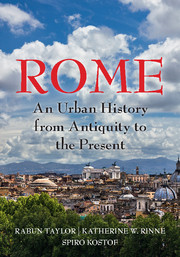Book contents
- Frontmatter
- Dedication
- Epigraph
- Contents
- List of Illustrations
- Acknowledgments
- Map
- INTRODUCTION
- 1 A BEND IN THE RIVER
- 2 A STORYBOOK BEGINNING
- 3 IDEOLOGICAL CROSSFIRE
- 4 BIG MEN ON THE CAMPUS
- 5 RES PUBLICA RESTITUTA
- 6 MEMORIALS IN MOTION: SPECTACLE IN THE CITY
- 7 THE CONCRETE STYLE
- 8 REMAKING ROME'S PUBLIC CORE: I
- 9 REMAKING ROME'S PUBLIC CORE: II
- 10 CRISIS AND CONTINUITY
- 11 RUS IN URBE: A GARDEN CITY
- 12 ADMINISTRATION, INFRASTRUCTURE, AND DISPOSAL OF THE DEAD
- 13 MAPPING, ZONING, AND SEQUESTRATION
- 14 TETRARCHIC AND CONSTANTINIAN ROME
- 15 TROPHIES AND TITULI: CHRISTIAN INFRASTRUCTURE BEFORE CONSTANTINE
- 16 WALLS MAKE CHRISTIANS: FROM FOURTH TO FIFTH CENTURY
- 17 A TALE OF TWO ROMES
- 18 THE ROME OF GOTHS AND BYZANTINES
- 19 CHRISTIAN FOUNDATIONS
- 20 FROM DOMUS LATERANI TO ROMANUM PALATIUM
- 21 THE LEONINE CITY: ST. PETER'S AND THE BORGO
- 22 VIA PAPALIS, THE CHRISTIAN DECUMANUS
- 23 THE URBAN THEATERS OF IMPERIUM AND SPQR
- 24 HOUSING DAILY LIFE
- 25 CHAOS IN THE FORTIFIED CITY
- 26 THE TIBER RIVER
- 27 HUMANIST ROME, ABSOLUTIST ROME (1420–1527)
- 28 PLANNING COUNTER REFORMATION ROME
- 29 PROCESSIONS AND POPULATIONS
- 30 MAGNIFICENT PALACES AND RHETORICAL CHURCHES
- 31 NEOCLASSICAL ROME
- 32 PICTURING ROME
- 33 REVOLUTION AND RISORGIMENTO
- 34 ITALIAN NATIONALISM AND ROMANITÀ
- 35 A CITY TURNED INSIDE OUT
- Glossary of Persons, Places, and Terms
- Works Cited
- Index
16 - WALLS MAKE CHRISTIANS: FROM FOURTH TO FIFTH CENTURY
Published online by Cambridge University Press: 05 July 2016
- Frontmatter
- Dedication
- Epigraph
- Contents
- List of Illustrations
- Acknowledgments
- Map
- INTRODUCTION
- 1 A BEND IN THE RIVER
- 2 A STORYBOOK BEGINNING
- 3 IDEOLOGICAL CROSSFIRE
- 4 BIG MEN ON THE CAMPUS
- 5 RES PUBLICA RESTITUTA
- 6 MEMORIALS IN MOTION: SPECTACLE IN THE CITY
- 7 THE CONCRETE STYLE
- 8 REMAKING ROME'S PUBLIC CORE: I
- 9 REMAKING ROME'S PUBLIC CORE: II
- 10 CRISIS AND CONTINUITY
- 11 RUS IN URBE: A GARDEN CITY
- 12 ADMINISTRATION, INFRASTRUCTURE, AND DISPOSAL OF THE DEAD
- 13 MAPPING, ZONING, AND SEQUESTRATION
- 14 TETRARCHIC AND CONSTANTINIAN ROME
- 15 TROPHIES AND TITULI: CHRISTIAN INFRASTRUCTURE BEFORE CONSTANTINE
- 16 WALLS MAKE CHRISTIANS: FROM FOURTH TO FIFTH CENTURY
- 17 A TALE OF TWO ROMES
- 18 THE ROME OF GOTHS AND BYZANTINES
- 19 CHRISTIAN FOUNDATIONS
- 20 FROM DOMUS LATERANI TO ROMANUM PALATIUM
- 21 THE LEONINE CITY: ST. PETER'S AND THE BORGO
- 22 VIA PAPALIS, THE CHRISTIAN DECUMANUS
- 23 THE URBAN THEATERS OF IMPERIUM AND SPQR
- 24 HOUSING DAILY LIFE
- 25 CHAOS IN THE FORTIFIED CITY
- 26 THE TIBER RIVER
- 27 HUMANIST ROME, ABSOLUTIST ROME (1420–1527)
- 28 PLANNING COUNTER REFORMATION ROME
- 29 PROCESSIONS AND POPULATIONS
- 30 MAGNIFICENT PALACES AND RHETORICAL CHURCHES
- 31 NEOCLASSICAL ROME
- 32 PICTURING ROME
- 33 REVOLUTION AND RISORGIMENTO
- 34 ITALIAN NATIONALISM AND ROMANITÀ
- 35 A CITY TURNED INSIDE OUT
- Glossary of Persons, Places, and Terms
- Works Cited
- Index
Summary
CONSTANTINE'S LEGALIZATION OF CHRISTIAN WORSHIP USHERED IN A FRESH environmental order that would soon support a new political and social era – one that gave the empire a historic challenge, and for the constructive energies of the imperial machinery, a program of vast scope and diversity. Forging a theater for the new state religion was both open-ended and restricted by Christian precedent, creating architectural and urban innovation that was simultaneously tradition breaking and conservative. The shape this willed ambience of devotion would take was not prescribed. Constantine's actions would shake the world; and the official Christianization of Rome's built fabric, for all its logic, has something of the revolutionary and astounding about it.
Consider this. The generation born in Rome at the turn of the fourth century would have witnessed, within its lifetime, the new monumentality of the Roman countryside, where, by midcentury, new, expansive cemeterial basilicas, visible from afar, protected the martyrs’ graves and loomed along the consular roads a mile or two beyond the Aurelian Wall. The Lateran quarter became a busy administrative and ritual nucleus that contrasted sharply with its sedentary, heretofore almost rural existence. Unfamiliar traffic patterns within and without the city directed people toward these very magnets of urban life. The great military garrisons such as the Castra Praetoria had been closed and some others demolished, and the Palatine's bureaucratic bustle quieted. St. Peter's modest tomb forced the unlikely and difficult transformation of the Vatican district from a quiet suburb to a center of international pilgrimage. Rome was still a familiar city, of course, but in retrospect it seems propelled on an irreversible path of transmutation.
This first crucial period for the medievalizing of Rome – the fourth century – witnessed major building activity. On the secular side there were Constantine's baths, his remodeling of the Basilica of Maxentius, the Basilica of Junius Bassus, new triumphal arches, renovated urban bridges, and a new colonnaded street that traversed the Campus Martius heading toward the Vatican, the so-called Porticus Maximae (see Figs. 91, 104). This impressive colonnaded avenue built between 379 and 383 probably began at the Theater of Balbus and reached the Pons Aelius at Hadrian's mausoleum, giving access to the complex of St. Peter's.
- Type
- Chapter
- Information
- RomeAn Urban History from Antiquity to the Present, pp. 151 - 159Publisher: Cambridge University PressPrint publication year: 2016



